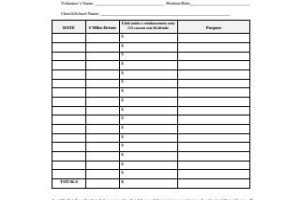Table of Contents
A sample volunteer program budget is a useful tool for planning and managing the financial aspects of a volunteer program. It helps organizations estimate and allocate funds for various program expenses such as recruitment, training, supplies, and recognition. This budget template can serve as a guide to ensure that the program remains cost-effective and sustainable while maximizing its impact on the community.
The Sample Volunteer Program Budget serves as a crucial tool in planning and managing the financial aspects of any volunteer program. With meticulous attention to detail and careful consideration of all expenses, this budget ensures that resources are allocated efficiently and effectively. As we delve into the intricacies of this budget, we will explore the various components that make it comprehensive and reliable. From outlining the program’s goals to estimating the costs associated with recruitment and training, this budget leaves no stone unturned. Whether you are an experienced program coordinator or a newcomer to the world of volunteering, this budget will provide you with valuable insights and strategies to optimize your program’s financial performance.
Introduction
Creating a well-planned and organized volunteer program is crucial for the success of any nonprofit organization. However, managing the financial aspects of such a program can be challenging. A volunteer program budget helps allocate resources effectively and ensures that the program runs smoothly. In this article, we will outline the key components of a sample volunteer program budget and provide insights on how to create one.
Defining the Budget Period
The first step in creating a volunteer program budget is to define the time frame for which the budget will be prepared. Typically, budgets are created annually or on a project basis. By determining the budget period, you can ensure that all expenses and revenue sources are accounted for accurately.
Income Sources
Identifying potential income sources is essential to fund your volunteer program. This could include grants, donations, fundraising events, or sponsorships. Consider both one-time and recurring sources of income, as well as any specific restrictions or requirements associated with each source.
Expenses
It is crucial to identify and categorize all the expenses associated with running a volunteer program. These may include personnel costs, volunteer training and recognition, marketing and communication expenses, program materials, and administrative overheads. By breaking down expenses into categories, you can better manage and allocate your resources.
Personnel Costs
The personnel costs section of your budget should include salaries, benefits, and any other related expenses for staff members responsible for managing the volunteer program. This may also include costs for hiring temporary staff or consultants, if needed.
Training and Recognition
Volunteer training and recognition are essential for maintaining a motivated and engaged volunteer base. Allocate funds for training materials, workshops, seminars, and any necessary certifications or licenses. Additionally, consider recognition events, such as volunteer appreciation dinners or awards, to show your gratitude for their contribution.
Marketing and Communication
Effective marketing and communication strategies are crucial for attracting and retaining volunteers. Allocate a portion of your budget towards creating promotional materials, running social media campaigns, website maintenance, and any other communication tools required to engage potential volunteers.
Program Materials
Depending on the nature of your volunteer program, you may require certain materials or supplies. This could include uniforms, safety gear, office supplies, or specialized equipment. Consider all the necessary items and allocate a budget accordingly to ensure smooth program operations.
Administrative Overheads
Administrative overhead costs are associated with managing the volunteer program on a day-to-day basis. This could include expenses related to rent, utilities, insurance, software subscriptions, and general office supplies. Allocating a budget for administrative overheads ensures smooth program management and operation.
Contingency Fund
It is always wise to set aside a contingency fund within your budget to cater to unforeseen expenses or emergencies. A contingency fund acts as a safety net and helps you address unexpected situations without jeopardizing the overall functioning of your volunteer program.
Monitoring and Evaluation
Lastly, it is important to allocate resources to monitor and evaluate the effectiveness of your volunteer program. This may involve tracking key performance indicators, conducting surveys or interviews with volunteers, and analyzing feedback. By investing in monitoring and evaluation, you can continuously improve your program and make informed decisions based on data.
Conclusion
A well-planned volunteer program budget is crucial for the success and sustainability of your nonprofit organization. By carefully considering income sources, categorizing expenses, and setting aside funds for training, marketing, materials, and contingencies, you can ensure the smooth operation of your volunteer program. Regularly monitor and evaluate your budget to make adjustments as needed, and always strive for financial transparency and accountability within your organization.
Introduction to the Sample Volunteer Program Budget
This section provides an overview of the purpose of the sample volunteer program budget and highlights its significance in effective program planning and resource allocation.
The sample volunteer program budget serves as a crucial tool in ensuring the success and sustainability of a volunteer program. It outlines the financial resources required to support various aspects of the program, including personnel expenses, recruitment and screening costs, training and development, volunteer management software, supplies and equipment, outreach and marketing efforts, and program evaluation and impact measurement.
By creating a comprehensive budget, program managers can effectively plan for the allocation of resources, identify potential funding gaps, and ensure that the program’s objectives are met efficiently and effectively. Additionally, the budget provides transparency and accountability in financial management, allowing stakeholders to understand how their contributions are being utilized and the impact they are making.
Personnel Expenses
It is crucial to allocate funds for personnel expenses, including salaries, benefits, and training, which are essential for the successful implementation of the volunteer program and ensuring the well-being of staff members.
Staff members play a vital role in overseeing and coordinating volunteer activities, managing relationships with volunteers, and providing support and guidance throughout the program. Allocating funds for personnel expenses ensures that the program has qualified and dedicated staff members who can effectively carry out these responsibilities.
Salaries and benefits should be competitive to attract and retain skilled professionals who can effectively manage and support volunteers. Additionally, investing in training opportunities for staff members enables them to enhance their skills and knowledge, ultimately benefiting the volunteers and the overall success of the program.
Recruitment and Screening Costs
This subheading focuses on the expenses associated with volunteer recruitment and screening processes such as advertising, background checks, and interviews, which are critical for selecting suitable candidates and maintaining program integrity.
Recruiting and screening volunteers is an essential step in ensuring that the program attracts individuals who are committed, reliable, and aligned with the program’s mission and values. Allocating funds for recruitment efforts allows for targeted advertising campaigns, increasing the likelihood of attracting individuals who possess the necessary skills and qualities.
Screening costs, including background checks and interviews, are essential for safeguarding the well-being of program participants and maintaining program integrity. These expenses ensure that volunteers meet the necessary requirements and have undergone a thorough vetting process to ensure their suitability for the program.
Training and Development
Allocating funds for training sessions, workshops, educational materials, and team-building activities is important to foster the ongoing growth and skills enhancement of volunteers, leading to improved program outcomes.
Volunteers often require training to effectively carry out their assigned tasks and responsibilities. Providing comprehensive training ensures that volunteers have the necessary knowledge and skills to perform their roles efficiently, ultimately resulting in higher-quality services provided to program beneficiaries.
Investing in ongoing development opportunities, such as workshops and educational materials, allows volunteers to continuously enhance their skills and knowledge, enabling them to take on more responsibilities and contribute to the program’s success in a meaningful way. Additionally, team-building activities promote collaboration and a sense of belonging, which can improve volunteer retention and satisfaction.
Volunteer Management Software
Exploring the costs of implementing and maintaining volunteer management software can streamline administrative tasks, enhance communication, and improve volunteer engagement, making it an essential part of the program budget.
Volunteer management software offers numerous benefits, including streamlining the recruitment and onboarding process, tracking volunteer hours and activities, facilitating communication between volunteers and program staff, and providing data for program evaluation and reporting.
While there may be costs associated with implementing and maintaining the software, the benefits outweigh the expenses. By automating administrative tasks, staff members can allocate more time and resources to providing support and guidance to volunteers, ultimately enhancing their experience and engagement in the program.
Supplies and Equipment
This section highlights the need to allocate resources for necessary supplies and equipment that support the day-to-day operations of the volunteer program, such as office supplies, uniforms, safety gear, and IT resources.
Properly equipping volunteers with the necessary supplies and equipment is essential for them to carry out their assigned tasks effectively and safely. This may include office supplies for administrative tasks, uniforms or identification badges to establish a visible presence, safety gear for volunteers working in potentially hazardous environments, and IT resources for data management and communication purposes.
By budgeting for supplies and equipment, program managers ensure that volunteers have access to the tools they need to perform their roles efficiently, increasing productivity and overall program effectiveness.
Outreach and Marketing
Budgeting for outreach and marketing efforts, including online campaigns, brochures, and community events, can significantly impact the program’s success by attracting new volunteers, engaging stakeholders, and raising awareness.
Effective outreach and marketing strategies are essential for promoting the volunteer program and attracting individuals who are passionate about the cause. Allocating funds for online campaigns, such as social media advertising and search engine optimization, can increase the program’s visibility and reach a wider audience.
Additionally, printed materials such as brochures and flyers can be distributed at community events or shared with local businesses and organizations to raise awareness about the program and encourage volunteer participation. By investing in outreach and marketing efforts, program managers can generate interest and enthusiasm, ultimately leading to increased volunteer recruitment and engagement.
Program Evaluation and Impact Measurement
Dedicating funds towards conducting program evaluations and impact assessments allows for continuous improvement, evidence-based decision-making, and the demonstration of the program’s value and effectiveness to stakeholders.
Program evaluation and impact measurement are essential components of effective program planning and management. By allocating funds for these activities, program managers can assess the program’s progress towards its goals, identify areas for improvement, and make informed decisions regarding resource allocation.
Program evaluations provide valuable insights into the program’s strengths and weaknesses, enabling program managers to implement necessary changes and enhancements. Impact assessments, on the other hand, allow for the measurement of the program’s outcomes and its overall contribution to the community or cause it serves.
By demonstrating the program’s value and effectiveness through evaluation and impact measurement, program managers can secure ongoing funding, engage stakeholders, and build a strong foundation for future program growth and success.
As an organization dedicated to making a positive impact in the community, we understand the significance of creating and implementing a well-thought-out budget for our volunteer program. By carefully allocating financial resources, we can ensure the smooth operation and success of our initiatives. In this regard, we have developed a sample volunteer program budget that reflects our commitment to professionalism and efficiency.
1. Purpose and Objectives:
- Clearly define the purpose and objectives of the volunteer program.
- Identify the specific activities and initiatives that will be undertaken.
- Align the budget with the overall goals and mission of the organization.
2. Income and Revenue:
- Identify potential sources of income for the volunteer program, such as grants, donations, or sponsorships.
- Estimate the expected revenue from each source and incorporate it into the budget.
- Ensure transparency and accountability in tracking and reporting income generated.
3. Expenses and Expenditures:
- Determine the various expenses associated with running the volunteer program.
- Categorize expenses into areas such as recruitment, training, supplies, transportation, and administration.
- Estimate the cost for each category based on previous experiences and market research.
- Allocate funds accordingly, prioritizing essential expenses while considering cost-saving measures.
4. Staffing and Volunteer Support:
- Include costs associated with hiring and managing staff members responsible for overseeing the volunteer program.
- Budget for volunteer recruitment efforts, including advertising and outreach initiatives.
- Consider providing necessary support to volunteers, such as training materials, uniforms, or transportation reimbursements.
5. Monitoring and Evaluation:
- Allocate funds for monitoring and evaluating the effectiveness of the volunteer program.
- Consider investing in tools or software that can streamline data collection and analysis.
- Prioritize continuous improvement by using evaluation results to make informed budgetary decisions.
By adhering to a professional voice and tone, we emphasize our commitment to responsible financial management. This sample volunteer program budget serves as a blueprint for ensuring that resources are allocated efficiently, allowing us to maximize the impact of our efforts. We recognize the importance of transparency and accountability in our financial practices, and this budget exemplifies our dedication to professionalism in all aspects of our organization.
Thank you for taking the time to explore our Sample Volunteer Program Budget. We hope that this resource has provided you with valuable insights and guidance on how to effectively manage the financial aspects of your volunteer program. As you embark on your journey to create a budget that aligns with your organization’s goals, we encourage you to keep in mind the professional voice and tone required to ensure its success.
First and foremost, it is crucial to approach your budgeting process with a strategic mindset. Begin by clearly defining the objectives and scope of your volunteer program. This will allow you to identify the specific expenses that need to be accounted for and allocate resources accordingly. Whether it’s recruiting and training volunteers, organizing events, or covering administrative costs, each aspect of your program should be evaluated in terms of its financial impact.
Transition words such as furthermore, in addition, and moreover can be used to effortlessly guide your audience through the various sections of your budget. By including these words and phrases, you create a logical flow that enhances the readability and comprehension of your document. For example, when discussing different expense categories, you can use transition words to seamlessly transition from one category to another, ensuring a smooth and organized presentation.
Additionally, maintain a professional tone throughout your budget to convey credibility and expertise. Use concise and clear language, avoiding jargon or overly technical terms that may confuse your readers. Remember, your budget serves as a communication tool between you and potential stakeholders or decision-makers. Therefore, it is vital to present the information in a manner that is easily understood by individuals who may not have an extensive background in finance or budgeting.
In conclusion, our Sample Volunteer Program Budget aims to assist you in creating a comprehensive and well-structured financial plan for your volunteer program. By adopting a strategic mindset, utilizing transition words, and maintaining a professional tone, you can convey your organization’s financial needs and objectives effectively. We hope this resource has empowered you to develop a budget that optimizes your volunteer program’s success and enables you to make a meaningful impact in your community. Best of luck on your budgeting journey!
.
1. How do I create a sample volunteer program budget?
To create a sample volunteer program budget, follow these steps:
- Identify the key expenses: Start by listing all the necessary expenses for your volunteer program, such as recruitment, training, supplies, transportation, and administrative costs.
- Estimate costs: Research and estimate the costs associated with each expense category. This can be done by contacting suppliers, researching prices online, or referring to previous budgets.
- Consider revenue sources: Determine potential revenue sources for your volunteer program, such as donations, grants, or fundraising activities.
- Allocate funds: Allocate funds from your revenue sources to cover the estimated expenses. Ensure that the budget is realistic and aligns with the goals and objectives of your volunteer program.
- Monitor and adjust: Continuously monitor your budget throughout the program’s duration and make adjustments as needed. Keep track of actual expenses and compare them to the budgeted amounts.
2. What factors should I consider when creating a volunteer program budget?
When creating a volunteer program budget, consider the following factors:
- Program objectives: Ensure that your budget supports the goals and objectives of your volunteer program.
- Volunteer numbers: Take into account the number of volunteers you expect to engage and plan accordingly for recruitment, training, and support.
- Duration: Consider the length of your program and how it may impact expenses such as transportation, supplies, and meals.
- Location: Different locations may have varying costs of living and transportation, so consider these factors when estimating expenses.
- Partnerships and resources: Explore partnerships or in-kind donations that can help reduce costs and stretch your budget further.
3. How can I ensure financial transparency in my volunteer program budget?
To ensure financial transparency in your volunteer program budget, you can:
- Maintain detailed records: Keep thorough documentation of all financial transactions related to your volunteer program.
- Provide regular reports: Share financial reports with stakeholders, volunteers, and donors to demonstrate how funds are being utilized.
- Implement checks and balances: Establish internal controls to prevent any misuse or misappropriation of funds.
- Seek external audits: Consider having an independent auditor review your financial records periodically to provide an unbiased assessment of your budget management.
- Promote accountability: Encourage open communication and accountability among team members and volunteers regarding budget-related matters.
4. Are there any software or tools available to help with volunteer program budgeting?
Yes, several software and tools can assist you with volunteer program budgeting. Some popular options include:
- Microsoft Excel: Utilize spreadsheet software like Microsoft Excel to create and manage your budget, track expenses, and perform calculations.
- Online budgeting tools: Explore online budgeting platforms specifically designed for nonprofits and volunteer programs, such as BudgetPulse or Mint.
- Accounting software: Consider using accounting software like QuickBooks or Xero, which offer features for budgeting, expense tracking, and financial reporting.
- Project management software: Certain project management tools like Asana or Trello also offer budget management features that can be adapted for volunteer program budgets.
5. How often should I review and update my volunteer program budget?
It is advisable to review and update your volunteer program budget on a regular basis. The frequency of reviews may depend on the duration and complexity of your program. However, as a general guideline:
- Review your budget quarterly: At a minimum, review and assess your budget’s performance on a quarterly basis to ensure it aligns with your program’s progress.
- Adjust as needed: Make adjustments to your budget whenever there are significant changes in your program’s activities or funding sources.
- Revisit annually: Conduct a comprehensive review and revision of your budget at least once a year, considering any new goals, objectives, or changes in expenses.
Remember, creating and managing a volunteer program budget requires careful planning, monitoring, and transparency to ensure the effective utilization of resources and successful program implementation.






